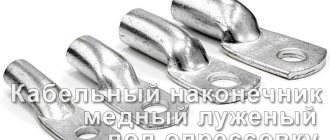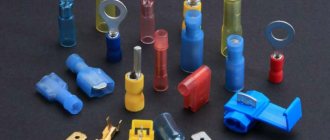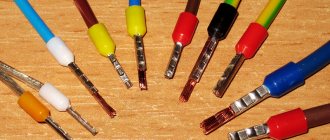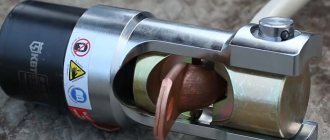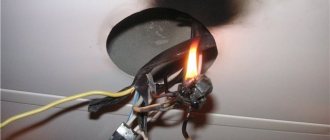Home » Electrical installation » Electrician's tools » TML tip
The TML tip is a special device that allows you to create the best contact between the device wires and the network. The letter “T” in the marking indicates that the part is made of pipe. The letter “M” indicates that the product is made of copper, and the letter “L” means that the contact is tinned.
Copper tinned tip
In this article we tried to look at what tips exist and what they are intended for.
General information
Simply connecting a household appliance to the network is sometimes simply not enough. If there is poor contact, the wire will begin to experience various overloads when voltage is applied. Accordingly, this will lead to failure of the device or fire of the wiring.
Popular wire lugs
To avoid such unpleasant situations, you need to make sure that the connection is made securely. The TML tip can help cope with such problems. Manufacturers make this element from various materials, but copper is considered the highest quality.
Required Tools
Crimping is carried out with a special tool that allows you to create the necessary force. The following tools are popular:
- press pliers for crimping modifications PK2 and PK2M. Used for terminating cores with a cross-section of up to 10 square meters. mm;
- PK1 and PK1M brand tools are a more powerful version of hand pliers;
- hydraulic pliers allow you to crimp wires up to 10 sq. mm;
- In industrial production, a hand press is used. It is suitable for wires up to 240 sq. mm;
- hydraulic press with electric drive is used for cables up to 300 sq. mm.
Press pliers with hinges increase the pressure of the tool, which makes the manual crimping process easier. Devices with a ratcheting mechanism are especially convenient. They prevent the instrument from unclenching until the procedure is completed.
When the choice of tips is made, proceed to the selection of the necessary crimping tool. One type of professional tool is hand press pliers, or crimpers. They are designed for crimping cables and wires.
Types of press jaws
The manual crimper is used for crimping non-insulated cable lugs, contact connectors, terminals and contact sleeves of various sizes. If a manual crimper has special blades (usually they are located where the handles are attached), then this tool can also be used for cutting cables and wires.
Electric pliers are a multifunctional tool for professional use. They can do almost any work with wires. Electric pliers are mainly used for cutting and stripping wires, but they can also be used to crimp uninsulated and insulated cable ends.
A crimper is a tool for crimping wire lugs, twisted pair cables, and connectors. It has two long handles (one or both can be movable) and a massive working part in the form of metal jaws, which have holes for cables.
When the handles are brought together, the jaws close and the cable connector is crimped using forceful pressing. Some models have a blade on the working part, which simplifies the work - no additional tools are required to cut the cable.
How to choose press jaws
How to choose press jaws:
- Crimping range. This characteristic shows the maximum and minimum cable cross-sections that manual press pliers are capable of crimping. If you have to work with cables of small sections, then you should choose press jaws with a range from 0.5 to 6 mm2, and for thick cables you need to purchase a tool with a range of 10 - 25 mm2.
- Handle insulation. Typically, the handles of press pliers are made of plastic, but some models of crimpers have special rubberized inserts. Rubber does not conduct electric current, so if the cable being worked with manual press pliers is energized, the person will not be in danger of electric shock.
Author: Sergey Vladimirovich, electrical engineer. More about the author.
Termination and crimping
Tinned copper lugs TML are intended for terminating bare copper contacts. To install this device on the wire cores, crimping pliers are usually used. When making tips, manufacturers can use copper pipes with different diameters. During the manufacturing process, they are cut and then compressed on one side. Subsequently, a small hole is made, which is intended for the bolt.
Types of tips for crimping
Crimping of TML tips is carried out for the following purposes:
- to establish a connection between the electrical network and the required device;
- to establish contact within one device between several parts;
- for “splicing”, when there is a need to extend an existing wire by connecting another to it.
Main types
There are different types of lugs for use with wires of different modifications and cross-sections. Let's look at the most popular of them:
- Copper.
Used to work with copper wires. They are made from seamless tubes. On one side there is a clamping part, and on the other side there is a tubular hole for the wire. This type of product is used for installing electrical appliances, connecting input distribution devices and for grounding.
- Aluminum.
For aluminum cores, connecting parts made of the same material are used. At one end there is a contact blade with a hole, and at the other there is a tubular hole. The cores are connected to the tip by crimping with a special tool. The product is first lubricated with quartz vaseline lubricant, which protects against oxidation.
- Aluminum-copper.
Switchgears can use copper busbars, for which aluminum-copper terminations are suitable. In them, the landing tube is made of aluminum, and the contact blade is made of copper. Products are made using the friction diffusion method or gas-dynamic spraying method. In this case, copper plating covers the product on top, which allows for stable contact.
- Bolted.
Fastened with a clamping bolt. In this case, crimping is not necessary, since the bolt is part of the contact connection. Tightening is done with a wrench.
Tip with viewing window
The TML(o) tip is one of the varieties of these elements. They are also made from copper. However, the main difference is that the design included a viewing window. This allows you to verify that the contact has been connected correctly. Most often, specialists use such varieties in industrial enterprises, so not everyone knows about the existence of this tip.
TML(o) is one of the types of tips
Mounting features
There are several common ways to attach a cable clamp. They all differ in complexity, connection quality and the need for additional equipment. Terminations are installed on the wire using the following methods:
- Crimping - clamping the tip with the cable inserted into it with special pliers.
- Fastening using a bolt or screw. Such fixation is possible only in special products designed for this purpose. They have a hole complete with a bolt. The wire is inserted into the tip until it stops, and a bolt of suitable size is completely tightened. Provided the work is done well, the connection is quite strong.
- Welding.
- Soldering.
The simplest method is crimping, however, in the absence of press pliers and the need to crimp the power cable, this method will be very difficult. Therefore, you can use soldering or, if possible, a screw connection. In industrial conditions, a mechanical or hydraulic press is used for crimping.
Copper tips
The most durable part is considered to be the one made of copper. A cheaper option is a brass ferrule. Many who have purchased these parts have probably encountered a large number of numbers on the packaging. Most often the numbers indicate:
- wire section;
- contact rod diameter;
- internal diameter of the shank.
There are several other types of tips, and to understand what they are, you need to understand the markings:
- The marking “TA” indicates that the part was manufactured from tubular aluminum.
- "SIP" indicates that the lug is an insulated self-supporting ring plate connector.
- The pin bushing element is designated as “NSHVI”.
- The most common marking is the designation “TML-10”. The number indicates the diameter of the wire, as well as the diameter of the contact rod.
Fixation options
One of the mounting options is bolted. In this case, the depth of fixation of the cable in the part will be fixed by the head of the bolt. Before connecting these two elements together, it is necessary to strip the required length of cable from the winding to expose the core. It is worth noting that the press can have different sizes, which depend on the area of application of the tool. However, the most popular recently have become those that can change their size, like an adjustable wrench. The change parameters range from 0.25 to 1 mm. There is another important detail here - there is no need to use pliers for work. The reason for this was that a hand press with this size is most often used for crimping very thin cables that can break under the strong pressure exerted on it by pliers.
Installing Items
At the moment there are 4 ways that allow you to install tips:
- Crimping.
- Screw.
- Welding.
- Soldering tips.
You can cope with the first installation option using 4 different tools. Each tool has its own qualities and properties that need to be studied before performing work. For example, to connect the power cable and the tip, you should use a more powerful tool.
How to choose the right terminals for wires
When choosing the most suitable cable lug, you need to be guided by the fact that the electrical conductor and sleeve correspond to the specified automatic parameters. This principle is relevant for any fixation, since when using a shank with a large diameter, there is free space that impairs contact.
There is no need to fill and crimp it with debris using wire or solder, as this may solve the problem. The plate is selected according to the diameter of the hole and the cross-section of the bolt or terminal. They are also chosen based on the quality of the core. If the crimped terminal and dielectric have a bare area, it may cause oxidation, fracture and fire.
Correspondence of diameter to bolt cross-section